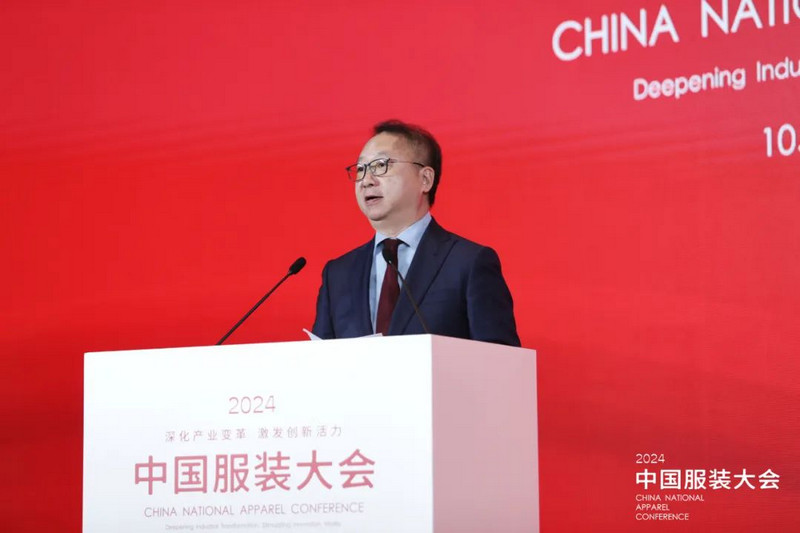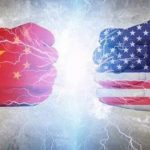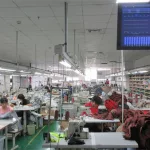 On October 17, 2024, the 2024 China Clothing Conference was grandly held. Sun Ruizhe, President of the China Textile and Apparel Federation, attended the conference and delivered an important speech.
On October 17, 2024, the 2024 China Clothing Conference was grandly held. Sun Ruizhe, President of the China Textile and Apparel Federation, attended the conference and delivered an important speech.
Strengthen confidence, work hard, and create a bright future with new quality and new strength
The Third Plenary Session of the 20th CPC Central Committee focused on the theme of Chinese-style modernization and made systematic arrangements for further deepening reform in an all-round way. The plenary session put the construction of a high-level socialist market economic system in a prominent position, and proposed to improve the system and mechanism that is conducive to promoting high-quality development, adhere to and implement the “two unshakable” principles, build a unified national market, promote high-level opening up, promote high-level scientific and technological self-reliance, build a modern economic system, and promote the gathering of various advanced production factors to develop new quality productivity. This provides fundamental compliance and strategic guidance for the high-quality development of the textile industry in the new era.
In the new development stage, the industry is experiencing a major shift in ideas and concepts, a major change in development methods, and a major adjustment in the structure of interests. Between making choices, more balance and determination are needed; between breaking and establishing, more foresight and wisdom are needed. The theme of this conference is “Deepening industrial transformation to stimulate innovation vitality”. It is to clarify the current situation, see the general trend, and find ways and paths to stimulate the industry’s endogenous power and innovation vitality. I would like to take this opportunity to share with you some of my insights.
Be rational and objective and correctly view the current industry situation
Since the beginning of this year, the industry has been operating smoothly and steadily, but it is indeed facing pressure due to the influence of internal and external situations. Especially since the second quarter, the growth rate of the textile and clothing industry has slowed down, and the profit decline has become more obvious.
From the perspective of external markets, the uncertainty of world development has weakened global consumption capacity and consumer confidence. As a leading industry in industrial transfer, the clothing industry is more deeply affected by geopolitics. In the US market, Vietnam, in the EU market, Bangladesh, and in the friendly and near-shore manufacturing, clothing is the first to bear the brunt. From January to August, my country’s clothing export value decreased by 1% year-on-year, 2.1 percentage points lower than the overall export of textiles and clothing.
From the perspective of domestic consumption, the pressure of domestic demand has increased. As a terminal industry, clothing is more sensitive to the market’s chill. From January to August, the retail sales of clothing, shoes and hats, and textile products above the designated size in my country increased by only 0.3% year-on-year, a decrease of 10.3 percentage points from the same period last year, and the growth rate of online clothing retail sales fell by 5.9 percentage points.
Don’t let the clouds block your view. Look at the main vein and the long-term when looking at problems. my country produces more than 70 billion pieces of clothing annually, which can provide about 8.75 pieces of clothing for each person in the world. The industry’s manufacturing capacity and trade scale are firmly ranked first in the world. From raw material supply, design and research and development to equipment manufacturing and channel innovation, the industrial chain is deeply integrated, and the advantages of the industry system and supply chain are unshakable. The domestic unified large market and regional industrial transfer cooperation form a strategic hinterland. This is the foundation for the “stability” of the clothing industry. Focusing on the development of new quality productivity, the vitality of the industry continues to increase. High-end, intelligent, green and integrated innovations are accelerating, and specialized and new enterprises are emerging. From January to August this year, fixed asset investment in the clothing industry increased by 15.5% year-on-year, leading the textile industry’s 13.5% and the chemical fiber industry’s 4.4%. We must see the golden edge of the dark clouds and be firm optimists. See opportunities in cold reception and complete the turning point in setbacks.
The industry is making rich explorations around category innovation, creating hits, and winning consumers’ “minds” with “extreme” products. We can summarize three important paths for value leap and innovation breakthrough.
Lifestyle brands in the context of scene refinement
Biyinlefen focuses on the niche and positions itself at the high end. Its gross profit margin in the first half of the year reached 77.86%, higher than Hermès’ 71% and LVMH’s 69%. Niche sports products such as tennis, golf, equestrianism, yoga, and camping have become a fashion. New life and values are being transformed into new fashion and consumption concepts. From sports fashion to casual formal wear, from travel clothing to sleep suits, from ice and snow equipment to pet clothing, changes in lifestyle have become an important content context and development space for China’s fashion innovation. Sun protection clothing, home clothes, shark pants, and sweat-inducing clothing focus on the details of life and are both functional and beautiful. Category innovation leads the world and has become an important track for brand incubation. For example, SIINSIIN, which was established only three years ago, has achieved the TOP1 of Tmall’s “Shark Pants” category. This year, the explosive product “Light Plastic Sun Protection Clothing” was launched on June 18. Integrating into life, enlightening life, innovating products and services around lifestyle and life attitude, and establishing a brand image are important entry points for industrial leapfrogging.
Chinese aesthetic brands with a focus on features
The excavation and transformation of Chinese elements are forming the path for the rise of China’s fashion industry. Cashmere, silk, linen and other clothing with distinct Chinese characteristics and symbolic meanings have performed well. From the application of elements of ancient metaphysics and traditional patterns to the systematic expression of historical culture and national intangible cultural heritage, from buttons, cloud shoulders, embroidery, tassels, to Song brocade, Xiangyun gauze, and horse-faced skirts, the new Chinese style has become a new wave of fashion. Mobile games, short dramas and other cultural and creative industries have built a new traffic entrance and value source for the industry around IP. Games such as “Black Myth: Wukong” and “Ru Yuan” have successfully created an ecosystem where the fashion industry, content, and cultural tourism industries coexist in harmony. The industry must establish cultural confidence, stick to the main roots and main veins, and integrate point-based breakthroughs into systematic innovation. Create Chinese fashion style and aesthetics with Chinese materials, Chinese design, and Chinese craftsmanship. Seize the opportunity of the shift of fashion sources to content platforms, gather traffic, increase voice, show appearance, and create value.
Hard-core functional brands empowered by technology
Restarting social cognition and reshaping consumer mentality is fundamentally based on hard power, and improving product quality through technological innovation. For example, as the company with the largest number of invention patents for goose down clothing in China, Gaofan Black Gold relies on its advantages in fabric material, heat storage lining, sealing technology, and antibacterial technology to create the ultimate single product. The company has dominated the list of various e-commerce platforms for two consecutive years on Double Eleven, successfully landed in Milan and Paris Fashion Week, and settled in Ruijin Shangpin, adjacent to international high-end luxury brands. The application of high-performance new materials such as graphene, carbon fiber, and aramid is greatly improving the performance of products in terms of sun protection, flame retardancy, wear resistance, conductivity, antibacterial, color change, and chemical resistance. 3D printing promotes the rapid realization of complex designs, and smart fibers promote the development of smart wearable products. At this year’s Paris Olympics, the shooting suit fabric developed by the Beijing Institute of Fashion Technology, the five-star battle suit III created by Biyinlefen, and the sun protection equipment provided by Moution all reflect this trend. Deepening material and process innovation and developing cost-effective, multi-functional, high-performance, intelligent, and green products are the key to China’s clothing brands overtaking on the curve.
Keep pace with the times and grasp the new logic of industrial development
Technological innovation drives the leap of the industry, and the deepening of development is accompanied by the iteration of problems. The direction must be balanced, the degree must be grasped, the intensity must be controlled, and the rhythm must be grasped. Developing new quality productivity is not only a change in development mode, but also a change in development concept. We need to seek new perspectives and logic in disenchantment and reconstruction.
New innovation logic: technology-driven and creating future value
The integration with cutting-edge technologies and future industries is of strategic significance for reshaping the image of the industry, seizing the initiative of development, and building new advantages. The development of the industry needs to look at the present from the perspective of the future. We should pay attention to intelligent transformation. The 2024 Nobel Prize in Physics and Chemistry was unprecedentedly awarded to three AI scientists. “AI+Science” and “AI+Design” have become innovation paradigms. AI is accelerating its integration into scenarios such as intelligent manufacturing, smart marketing, flexible supply chain, and industrial metaverse. For the industry, the improvement in labor productivity brought about by intelligent transformation is a structural impact. Since 2018, the unit output growth of the manufacturing industry in the United States and Germany has almost stagnated. Generative artificial intelligence, the exploration of embodied robots in lights-out factories, is changing the situation. The future competitive advantage of the industry will come from the combination of talent and computing power. We should pay attention to green development. The global production system, circulation system, consumption system, and innovation system are shifting towards green. Carbon emission rights, energy use rights, water use rights, and pollution discharge rights have become green assets. Green energy and green material innovations change the input and output of the industry from the source; the green transformation of production processes and manufacturing models reshapes industrial connections; green management systems, standards and regulations change competitive advantages. The industry’s value judgment and cost advantages are being reshaped. The industry should enhance the value-added and management capabilities of environmental assets, promote the green and low-carbon transformation of the entire industry chain, and create new products and new value with new technologies and new models.
New product logic: demand-based and creating user value
The effective market is the landing point for industrial innovation to achieve value transformation. Compared with direct customers, end users reflect more essential market needs. The key to creating products lies in a deep understanding of the market and consumers. At present, changes in consumer demand structure, consumer habits and preferences, consumer capacity distribution, and consumer scenario segmentation have become fertile ground for the emergence of new products, new categories, new models, and new brands. We must adapt to the adjustment of social classes. For example, the delayed retirement policy and changes in career planning will form a “silver-haired working class” aged 50-65. In the future, the demand for professional clothing that emphasizes comfort and quality and has health care, protection and other functions may increase. We must grow with the customer base. We must do a good job in customer base maintenance and tracking, and promote brand building by accumulating crowd assets and consumer education. For example, Jiangnan Buyi has been focusing on customer management for 30 years, with revenue of 5.24 billion yuan in fiscal year 2024, a year-on-year increase of 17.3%. Highly sticky fans contribute more than 80% of retail sales. We must be good at capturing customer perceived value. Products are becoming a collection of all perceived things and images related to people’s needs. Cultural identity, experience economy, and emotional value are becoming increasingly important. For example, Jellycat sold its thermos-sized plush toys at an average price of more than 360 yuan through immersive marketing. Product innovation should not only focus on technical details, but also impress people.
New competitive logic: quality first, creating ecological value
Platform economies such as content e-commerce and cross-border e-commerce are shaping a new ecology for industrial development. By connecting directly to consumers and integrating the supply chain, economies of scale and scope can be unified. In 2023, Douyin e-commerce apparel contributed 69% of the incremental share of the entire network. More cost-effective “white-label” products and substitute products are pouring into the market, and designer brands and emerging brands are developing rapidly. New problems are also emerging. For example, the deep bundling of the anchor’s personal IP and brand image may bring risks; problems such as high return rates caused by goods not matching the version, counterfeit and shoddy goods, etc. What is particularly serious is that this ecology tends to form a highly involuted hyper-competitive market. As the main participants, small and medium-sized enterprises are limited by their scale capabilities. In the environment of excessive competition and stock market, they themselves have the problem of homogeneous competition. Traffic thinking further strengthens this trend. Many platforms use low prices as a competitive strategy, and the war of attrition, price war, and “theater effect” are obvious. Low-price, low-quality, high-frequency, and high-pressure competition make enterprises have no ability and space to innovate. False prosperity, superficial excitement, short-termism, zero-sum game, excessive efficiency at the expense of product quality, and increasing investment have resulted in a waste of resources. The industrial ecology, overall value, and brand building have been damaged. To promote the transformation from “white label” to brand, and from Internet celebrity to “long-term red”, companies need to avoid low-level homogeneous competition in an upgraded way and make cost-effectiveness a high quality.
New market logic: creating global value by going global
From global mergers and acquisitions to integrate resources of companies such as Bosideng, Anta, and Shenzhou, to the establishment of branches by international layouts such as Yishun and Jiangnan Buyi, to the popularity of cross-border e-commerce companies such as Shein and Temu overseas, going overseas has become the only way to build world-class companies. On the other hand, “If you don’t go overseas, you’ll be out” has become a consensus among more and more small and medium-sized enterprises. The best ones have begun to deeply embed themselves in the international high-end supply chain system. For example, Sand River Cashmere has appeared on the Paris Fashion Week many times, has more than 30 overseas cooperative stores, and is the first Chinese brand to enter Le Bon Marché, the top department store in Paris. As the only strategic R&D cooperative manufacturer of Copenhagen Fur in the world, Haining Musa Clothing has become a core supplier of first-tier luxury brands such as LV, Dior, and Fendi. Clusters going overseas are becoming increasingly popular. Clusters such as Shengze and Keqiao frequently appear at international fashion weeks; Shein is promoting the “National 500 Cities Industrial Belt Overseas Plan”. From products going overseas to brands going overseas, from production capacity going overseas to supply chain going overseas, and from enterprises going overseas to clusters going overseas, the industry is entering a “new era of navigation.” Faced with the new situation, enterprises need to balance development and security, go global with a more positive attitude, and promote localized innovation and diversified layout. The global South countries have similar demands for product performance, quality and cost as China, so enterprises should pay more attention to it when going global. It is necessary to accelerate the “integration of digital and business” and promote the coordinated development of cross-border e-commerce, strengthening the foundation and expanding sales, and promoting trade and production.
Strengthen confidence and create a bright future with new quality and strength
China has entered a new “reform period”. Faced with the complicated international and domestic situation, a new round of scientific and technological revolution and industrial transformation, and the new expectations of the people, the clothing industry should focus on technology, fashion, and green development to promote the high-end upgrading of traditional industries and the industrialization of cutting-edge technologies. In response to some new situations and problems, we must not only recognize the general trend and strengthen our confidence, but also face up to difficulties and actively respond, seize the opportunities of the incremental policy package to stabilize the economy, and promote the high-quality development of the industry with new quality and new strength.
We need to have an open pattern and create a double helix of global development and local development
We should accurately grasp the new logic of global supply chain cooperation, balance efficiency and safety, embed high-quality supply into the international market system, create competitive advantages, and turn the domestic red ocean into a global blue ocean. We should focus on localized innovation, compliance development, in-depth participation in diversified market layout, strengthen regional cooperation with Southeast Asia, the Middle East, Africa, etc., explore emerging markets, integrate global resources through joint ventures and mergers and acquisitions, carry out global cooperation, and achieve global development.
We must have innovative genes and create a double helix of technological innovation and industrial upgrading.
Grasp the development law of new quality productivity and promote industrial upgrading with underlying technology and key innovation. Promote the development and application of new materials and new processes, find the connection point between the industry and the fields of big health and bio-economy, and plan emerging industries and future industries in a forward-looking manner. Innovate products and services, develop the first-launch economy, and promote the industrialization and commercialization of innovative achievements in the form of first stores, first shows, and first exhibitions.
Core capabilities are needed to create a double helix of digital transformation and green development
Strengthen the foundation and collaborate with innovation to strengthen advanced manufacturing capabilities and promote intelligent, green, high-end and integrated development. Grasp the trend of artificial intelligence, integrate fragmented scenarios, accumulate high-quality data, do a good job of “artificial intelligence +”, and build design, manufacturing, marketing and brand building on “big data + big computing power + strong algorithms”. Strengthen the coupling relationship between intelligent manufacturing and green manufacturing, and promote the green and low-carbon transformation of the entire industry chain. Improve the standard system and promote ESG practices.
We must have cultural confidence and create a double helix of concept renewal and practical exploration
It is easy to establish things, but difficult to establish a mind. The industry should strengthen cultural subjectivity, improve its source-generating ability, stick to its true colors in historical inheritance, blend and learn from each other in real practice, innovate in future development, and form value propositions and fashion styles. It is necessary to explore cultural values in a larger space-time dimension and improve the research and release system of popular trends. It is necessary to grasp the changes in fashion paradigms brought about by artificial intelligence, comprehensively improve the industry’s cultural creativity and creation capabilities, and build a Chinese fashion discourse that integrates emotional, aesthetic, and experiential values.
“Without a far-reaching ambition, there will be no bright future; without hard work, there will be no great achievements.” In the journey of further comprehensively deepening reform, let us strengthen our confidence, take action as the top priority, move forward together, stick to the fundamentals, seek practical results, develop new quality productive forces, and create a bright new future together.





